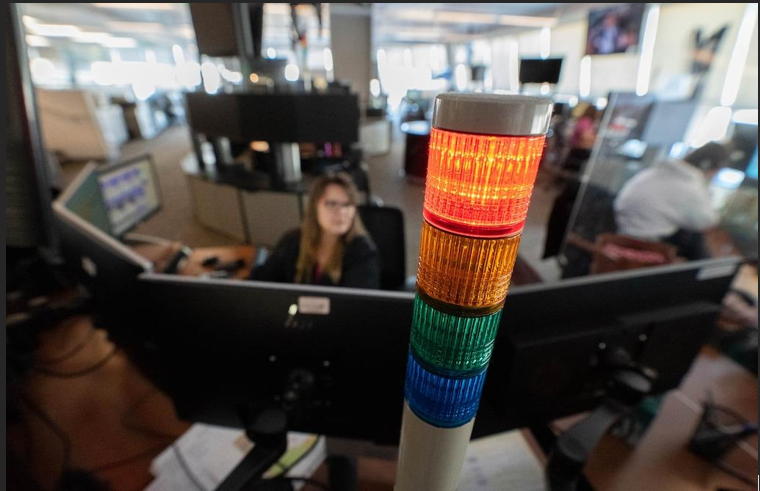A red light indicates an active call for Salt Lake City’s 911 operations inside the Public Safety Building.
Salt Lake City is tackling chronic understaffing and sky‑high non‑emergency call volumes by piloting an AI‑powered 911 triage system. The goal? Reroute up to 30% of non‑urgent calls away from human dispatchers, so they can focus on real emergencies.
What’s Driving the Move?
The Salt Lake City/Sandy 911 Communications Bureau fields roughly 653,000 calls annually . Of these, more than three‑quarters are non‑emergency—not life‑or‑death, but still essential matters. Chronic understaffing (15 vacancies among 100 dispatchers) and surging volumes have stretched the $11.7 million bureau thin .
To ease operational pressure, officials earmarked $326,000 from the E‑911 excise‑tax fund for implementing an AI‑assisted triage system, with deployment expected within six months .
Versaterm CallTriage: How It Works
The chosen system is Versaterm CallTriage, a conversational AI designed for public safety agencies . Seamlessly integrated with existing CAD/RMS systems (including Versaterm’s own) , it uses multilingual voice-driven interaction to:
- Greet callers and chart their requests
- Provide automated resolution or resource links
- Escalate critical calls back to human dispatchers
- Track performance via dashboards
The platform supports up to 36 languages with dialect recognition, addressing a growing immigrant population’s needs . It also flags high-stress voices or ambiguous inquiries and immediately forwards them to human staff .
Pilot Goals: Freeing Dispatchers, Retaining Humans
The primary objective is reducing non‑emergency call volume by about 30%, preserving response capacity for urgent incidents . Versaterm’s AI approach has succeeded in comparable deployments—easing “hold times” and improving staff morale in cities like Ottawa and Portland .
The system is not replacing dispatchers. Rather, it’s augmenting their workflow, automating routine tasks while ensuring human oversight where it matters most .
Safeguards & Public Perception
City officials are well aware of concerns around AI in emergencies. Council member Darin Mano emphasized ensuring callers aren’t “shocked” when AI answers the line . The bureau assures AI will only engage non‑emergency calls, and calls tagged as urgent or uncertain will be transferred to humans .
Dispatch director Lisa Kehoe noted that stress detection will reroute callers back to human operators if needed . Public outreach and education campaigns will accompany the rollout to minimize confusion.
Language Access & Equity
One major boon of the AI triage: real‑time translation and transcription across 36 languages and dialects. This is critical for non‑English‑speaking residents who previously relied on slower human translation services
Also Read:Blockchain Real Estate in Australia: The Rise of Tokenised Property
Broader Trends in AI 911
Salt Lake City is part of a wider shift among public safety agencies adopting automated solutions. Cities like Portland and Des Moines are also piloting AI triage tools to handle growing non‑emergency call volumes and staffing shortages.
Versaterm’s CallTriage, launched in 2023, has been adopted by PSAPs across North America. A GlobeNewswire release cited significant reductions in strain on dispatch centers following its rollout in cities such as Portland .
Measuring Success
Implementation includes performance metrics via dashboards tracking:
- Number/proportion of calls diverted from human dispatch
- Average caller wait and resolution times
- Language support throughput
- Escalation flags indicating possible AI misfires
Council discussions emphasized transparency and community trust, so results will be made publicly available and compared against benchmarks in other jurisdictions .
Long‑Term Impact & Replicability
A successful pilot in Salt Lake City may lead to broader adoption:
- Outreach campaign models to introduce AI triage systems
- Best practices on translation-enabled safety automation
- Scaling to rural or multi-language jurisdictions
- Cost-benefit models showing AI as an alternative to expanding hiring budgets
Looking Ahead: Next 6 Months
- Summer–Early Fall 2025: System procurement and integration with Versaterm CAD
- Fall 2025: Live testing begins; staff monitor call routing and AI performance
- Early 2026: Public rollout, communication campaigns, and first performance reporting
- Mid‑2026: Evaluation and potential expansion based on metrics
Why This Matters
Automating non-emergency routing preserves dispatcher bandwidth for life-critical situations, improves call efficiency, and elevates public safety staff morale. The multi-lingual, stress-detecting triage reflects Salt Lake’s commitment to modern, equitable public service. If successful, this pilot could serve as a national model for 911 modernization.


